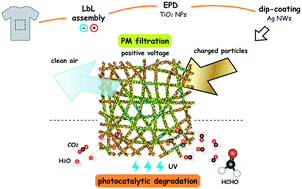Electrostatic polyester air filter composed of conductive nanowires and photocatalytic nanoparticles for particulate matter removal and formaldehyde decomposition†
Abstract
In light of the substantial threats to public health and quality of life brought about by air pollution, it is high time that we think of how we can protect human health and deal with particulate matter and volatile organic compounds in an efficient and economical manner. Herein, we demonstrate a dual-functional polyester fibrous air filter consisting of self-assembled titanium dioxide nanoparticles and percolated silver nanowires with high air permeability, and electrostatic particulate matter removal and photocatalytic formaldehyde decomposition abilities. The surface-functionalized polyester air filter reveals a remarkable particulate matter removal efficiency of up to 99.5% and a quality factor of 0.418 Pa−1 in heavy hazardous smoke, and it also retains a high removal efficiency of more than 87.4% after five filtration-cleaning cycles. Furthermore, with the aid of the decorated photocatalytic titanium dioxide nanoparticles, the same network can effectively degrade gaseous formaldehyde under UV irradiation. This strategy of surface-functionalizing nonwoven fabrics, which is reliable, easy-to-use, and low-cost, may open up promising alternative routes for tackling global air-pollution-related crises.

- This article is part of the themed collection: Environmental Science: Nano Cover Art


 Please wait while we load your content...
Please wait while we load your content...